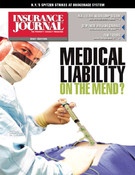Workers’ compensation writers in New Hampshire want an average 2.5 percent hike for voluntary market advisory loss costs and a 12.7 percent average increase in residual market premiums, according to the most recent filing from the National Council on Compensation Insurance (NCCI).
The bid reflects a steadying of claim frequency, weak hiring in high-risk construction and manufacturing fields and the continued aging of the state’s workforce.
The NCCI filing for 2005 also requests an increase in the minimum premium multiplier from 185 to 195 and a proposal for a jump in the rate differential for the residual market from 18 percent to 25 percent.
New Hampshire Insurance Commissioner Roger Sevigny held an Oct. 15 hearing date on the filing.
The latest filing follows the recent pattern in the state of small increases. For 2004, Sevigny approved a .5 percent increase in advisory loss costs for voluntary risks and a 7.7 percent hike in assigned risk rates. In 2003, the state granted a 1.3 percent voluntary loss costs increase and a 2.5 percent residual market hike.
In 2002, however, decreases of 6.7 percent and 5.9 percent, respectively, were implemented.
The filing came after NCCI presented an overview of the state’s workers’ compensation market showing that New Hampshire’s loss costs as a factor of payroll (1.55) compare favorably with those in nearby Maine (1.51), Rhode Island (1.63) and Vermont (1.70), although they come in slightly above the regional average (1.47) and well above the national average (1.27).
The NCCI snapshot showed how the profile of workers’ compensation risks in the state has changed since 1997. Clerical classes remain the largest category, but there are more professional, outside sales and retail risks than four years ago.
As for combined ratios, recent years have seen a steady improvement: 1999 (130%); 2000 (123%); 2001 (110%) and 2002 (106%).
Among the major trends in the Granite State cited by NCCI:
• After years of decline, claim frequency in the state appears to have leveled off. Out of every 100,000 workers, about 6,771 file claims.
• By injury type, 75.4% are medical only; 20.2% are temporary total; and 4.4% are permanent total or fatal.
• Claim frequency is not expected to rise very much, in part because of a “tepid” job outlook in the more hazardous construction and manufacturing sectors.
• Indemnity severity, however, could increase due to gains in wages and the aging of the state’s workforce.
As in previous reviews, NCCI noted that attorney involvement in New Hampshire’s worker compensation system is well below the countrywide average—only 6.4 percent of cases compared to 13.1 percent across the country.
The state’s residual market continues to grow in policy count, registering 10,229 in 2003, a 20 percent jump over 2002. Residual market premium volume jumped more than 30 percent to $34.4 million in 2003.
In 2003, New Hampshire’s residual market handled about 15.6 percent of the premiums written in the state, reflecting a slight increase from 2002’s share of 14.1 percent.
The vast majority (74%) of policies in the residual market are smaller premium accounts, with an annual premium under $2,499. The top classes by policy count in the residual market are clerical (8.6%); carpentry, family dwelling (5.9%); wallboard installation (4.4%); buildings, operations by owner (4.1%) and carpentry (3.5%).
Only 22 of the total 10,229 accounts have a premium exceeding $100,000.
The 2005 filing for the 2.5 percent voluntary loss cost increase proposes increases in the following industry groups: Manufacturing (4.1%); Office/Clerical (2.1%); Goods/Services (5.9%) and Miscellaneous (1.85). Only Contracting would loss costs be reduced (by 2.5%).
Topics Workers' Compensation Talent
Was this article valuable?
Here are more articles you may enjoy.


 AIG Files Amended Suit Against Former Execs, Dellwood Insurance
AIG Files Amended Suit Against Former Execs, Dellwood Insurance  Viewpoint: Deepfake Fraud Is On the Rise. Here’s How Insurers Can Respond
Viewpoint: Deepfake Fraud Is On the Rise. Here’s How Insurers Can Respond  What Happened to Reinsurance ‘Class of 2023’? Hard Market Defies Age-Old Patterns.
What Happened to Reinsurance ‘Class of 2023’? Hard Market Defies Age-Old Patterns.  Hard Market Conditions Expected to Ease in 2025 as Claims Inflation Softens: Swiss Re
Hard Market Conditions Expected to Ease in 2025 as Claims Inflation Softens: Swiss Re 


